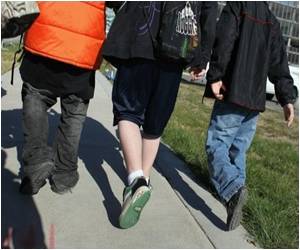A person's circle of friends influence his/her body weight, reveals study.

A student's social network also influences how active he or she is in sports. (By social networks, researchers mean face-to-face friends, not Facebook friends.) "These results can help us develop better interventions to prevent obesity," Shoham said. "We should not be treating adolescents in isolation."
The study was designed to determine the reason why obesity and related behaviors cluster in social networks. Is it because friends influence one another's behavior? (This explanation is called "social influence.") Or is it simply because lean adolescents tend to have lean friends and heavier adolescents tend to have heavier friends? (This explanation is called "homophily, or more informally, "Birds of a feather flock together.") Researchers used a sophisticated statistical technique to determine how much of the link between obesity and social networks is due to social influence and how much is due to homophily. This statistical technique is called "stochastic actor-based model," or SABM.
The researchers examined data from two large high schools that participated in the National Longitudinal Study of Adolescent Health (Add Health). One school, referred to as "Jefferson High," is in a rural area and has mostly white students. The second school, "Sunshine High," is an urban school with a substantial racial and ethnic diversity. Students were surveyed during the 1994-95 school year and surveyed again the following school year. Researchers examined data from 624 students at Jefferson High and 1,151 students at Sunshine High. Previously, researchers not affiliated with the current study asked students about their weight, friendships, sports activities and screen time. The body size measure they used was body mass index (BMI), which is calculated from a student's height and weight. A BMI over 25 is considered overweight and a BMI over 30 is considered obese.
Researchers found that part of the reason why obesity clusters in social networks was due to the way students selected friends. But even after controlling for this friend-selecting process, there still was a significant link between obesity and a student's circle of friends. For example, if a borderline overweight student at Jefferson High School had lean friends (average BMI 20), there was a 40 percent chance the student's BMI would drop in the future and a 27 percent chance it would increase. But if a borderline overweight student had obese friends (average BMI 30), there was a 15 percent chance the student's BMI would decrease and a 56 percent chance it would increase.
The findings, researchers concluded, show that social influence "tends to operate more in detrimental directions, especially for BMI; a focus on weight loss is therefore less likely to be effective than a primary prevention strategy against weight gain. Effective interventions will be necessary to overcome these barriers, requiring that social networks be considered rather than ignored."
Advertisement
Nevertheless, Shoham believes these results add to the vigorous debate over the relative importance of selection and peer influence in network studies of health. "Our results support the operation of both homophily and influence," he said. "Of course, no one study should ever be taken as conclusive and our future work will attempt to address many of these limitations."
Advertisement















